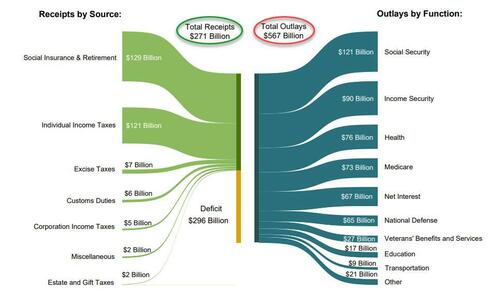Authored by Nick Corbishley via NakedCapitalism.com,
As life gets prohibitively expensive for many people living in the US (and other rich countries), relatively cheaper countries like Mexico are becoming increasingly attractive. But for local people the costs are growing.
Between January and September of 2022, Mexico issued 8,412 Temporary Resident Cards (TRT) to US residents, 85% more than in the first three quarters of 2019, according to a Mexican government migration report. Many are choosing to live in Mexico City. Such rapid growth rates have not been seen since comparable data became available in 2010. The number of Americans receiving permanent residency during that period has also risen sharply (48%), to 5,418.
But this may be just a fraction of the real number of American expats choosing to settle in Mexico. As the Mexican government has said for years, the number of Americans moving to its shores is likely far greater than the official figures suggest. According to data from the Ministry of Tourism (Sectur), over 10 million US citizens arrived as visitors through September this year, 24% more than in the same period of 2019. However, the Mexican authorities do not know exactly how many of those chose to stay.
A Growing Trend
In 2020, the US State Department estimated that 1.5 million USians were living in Mexico, more than double the number a decade earlier. That was before Usians began moving to Mexico at an even faster pace.
But why are so many choosing to move across the Southern border in the first place?
One reason is that it is remarkably easy. Mexico is at most a four- or five-hour flight away from most US cities. It has also been one of the most welcoming countries since the COVID-19 pandemic began, having implemented fewer COVID-19 travel restrictions than just about any other country on the American continent. Nor has it introduced vaccine passports. This has made it particularly attractive to digital nomads looking for affordable destinations with few COVID-19 restrictions.
Mexico is also remarkably cheap, as long as you are earning dollars, euros or some other hardish currency.
“Obviously, if you can earn in dollars and spend in pesos, you can triple your income,” Marko Ayling, a content creator and writer living in Mexico City told El País. “And that is very attractive to a lot of people who have the luxury of being able to work remotely.”
Unlike Mexicans in the United States, Americans can work in Mexico for up to six consecutive months on their tourist visas as long as they are paid from overseas. And, although technically not allowed, many choose to return to the US for a short period, then return to Mexico and renew their six-month period in the country, and that way continue working.
But it is not just Americans that are opting to live in Mexico. In fact, Mexico is apparently now the preferred destination for those moving abroad, beating off the likes of Indonesia, Vietnam, and even the popular expat hub Thailand. That’s according to this year’s edition of Expat Insider, an annual report published by InterNations, an expat community founded in 2007 that has been gathering data on expat/rich migrant flows and experiences for more than a decade.
Among the biggest draws highlighted by the survey are ‘the ease of settling in’ and ‘finances’. Of vital import to many people choosing to move abroad are how acccessible visas are to live and work in the countries, safety, and how expensive daily life is. Mexico may have not topped the ranking in all aspects, but it still came out on top with a higher average score.
The country also placed third on International Living‘s list of the best places to retire, just behind Panama (#1) and Costa Rica (#2). The accompanying report highlighted one of the key attractions for many retiring Americans: affordable heathcare:
A big part of the lower cost of living in Mexico is the healthcare. There are two government-run programs, including one (INSABI) that is basically free to Mexican citizens and foreigners with residence (there can sometimes be some small out-of-pocket expenses). This system is designed for those without the means to pay for any other healthcare and has facilities all around the country. Another government option is called IMSS, which costs about $500 per year per person. However, with IMSS pre-existing conditions are not covered.
There is also private healthcare, with clinics and hospitals with all the modern equipment and technology, and doctors of every specialty trained in the latest techniques and procedures. In fact, Mexico is a major medical and dental tourism destination for that reason. You can pay cash at a private facility (costs are a fraction of the U.S.—try $50 to $70 for a specialist visit, $300 for an MRI) or use local or international insurance.
Of course, Mexico has been a popular retirement destination for USians for decades, with places like San Miguel de Allende, Puerto Vallarta, Oaxaca, Cabo San Lucas and Chapala/Ajijic particularly in demand. But as life grows more expensive and more precarious for working- and middle-class USians, this trend is likely to intensify.
As a Brit living in Barcelona and married to a Mexican woman, I can understand the lure that draws people to Mexico. It is a beautiful, vibrant, exotic country with a bewitching color scheme, a rich culture and a diverse geography. The food is delectable and the people by and large warm, welcoming and supportive (in Spanish we would use the word “solidario,” meaning they have solidarity with others). The weather in the Valley of Mexico is temperate all year round. The biggest concern I personally would have about living in Mexico, which is something my wife and I are seriously considering, is its escalating water crisis.
The decision to switch one’s country of residence is usually a deeply personal one and is often triggered by both pull and push factors. Not only are you moving to somewhere new but you are also moving away from somewhere established and familiar, where many of your friends and family live. Speaking as someone who has spent the best part of his adult life living abroad, it is a huge step. I would be very interested to know from US readers who, live Yves, are thinking of leaving the US what their main motives are for doing so.
Security Concerns
Ironically, this gathering exodus to Mexico is happening at the same time that the US Federal Government is issuing blanket travel warnings for many Mexican states. In August the State Department issued alerts for 30 of Mexico’s 32 states, six of which (Colima, Guerrero, Michoacán, Sinaloa, Tamaulipas and Zacatecas) it warned US travelers against visiting altogether, due to the high risk of being kidnapped or attacked.
There is no doubt that security remains the primordial issue in Mexico, as it does in many other Latin American countries. Although the number of people dying in the war on and for drugs has ebbed slightly in the past two years, the country still boasts some of the highest homicide rates on the planet, with Zamora de Hidalgo at 196 per 100,000 people, Zacatecas at 107, and Tijuana at 103. Also, regions that were traditionally relatively safe, such as Puebla or Quintana Roo, have recently been caught up in the spiral of violence.
But for the most part, the danger zones are in small pockets of states close to the US border, where most of the drugs are trafficked, or parts of the Sierra Madre Occidental, where many of the drugs are grown. They are not, as the US travel alerts suggest, uniformly sweeping across states.
Another common misconception is that Mexico City, being one of the largest conurbations in the world, must also be one of the most dangerous places in Mexico. Yet in reality, Mexico City has largely escaped the worst of the cartel violence, for a slew of reasons outlined in a recent article by British expat journalist Ion Grillo. They include the fact that while the drug gangs have a presence in the capital, they do not control it:
[W]hile the mobsters are certainly here, they do not operate as they do in their strongholds. Mexico City is not a strategic turf to produce drugs (like in the Sierra Madre), or to traffic drugs to the United States (like on the border).
In Culiacán, gangsters exert an immense control of their territory, with lookouts on every corner and gunmen lurking in safehouses. In the capital, however, Sinaloa operators can disappear into the urban sprawl. It’s more a place to make deals, meet with contacts in the federal government, and launder money.
There’s also talk of a pax-mafiosi in the capital, an agreement between the big narcos not to fight here. I haven’t heard this straight from the mouth of crime figures, but this is possible, even perhaps as an informal understanding that they do business and not go to war like back in Tijuana.
Another factor is that Mexico is a heavily centralized country and all the federal agencies are here, along with the bulk of the governing class of politicians and heads of big business. These powers-that-be don’t want a mess on their own doorstep. The federal forces won’t allow a convoy of a hundred hitmen to blaze up Insurgentes avenue like they get away with doing in Zacatecas.
The extensive use of cameras and the mobilization of one of the largest unified city police forces in Latin America have also helped to keep a check on the violence. As Grillo documents, not only is Mexico City one of the less dangerous cities in Mexico; it is getting safer and is already less dangerous than some US cities:
The Mexico City [murder rates] don’t refer to the whole urban sprawl of 22 million but to the official capital district, now called CDMX, which has about 9.2 million people. The Mexican government keeps a database of the murder numbers from police and prosecutor records, and there is another database from morgues and death certificates.
The police count recorded a peak of 1597 murder victims here in 2018, dropping to 1006 last year. That gives Mexico City a murder per capita rate of about 10.9 per 100,000 in 2021. This year the number has dropped further still.
Comparing the 2021 figures, Mexico City still has a higher murder rate than New York (which had about 5.7 homicides per 100,000), but it is lower than Portland (12.9), Dallas (14.6) or Minneapolis (22.1).
The most murderous U.S. cities include Baltimore (57.5) and St Louis (65.3), which have extremely high levels considering the wealth and power of the United States.
Both Mexican President Andrés Manuel Lopéz Obrador (aka AMLO) and Mexico City mayor Claudia Sheinbaum, who is hotly tipped to succeed AMLO in 2024, have seized on this success to try to attract yet more visitors and expats to the city.
“How much we have advanced on the issue of security,” said AMLO in a recent daily press conference. “Because of this, thousands of foreigners have arrived to live in Mexico City…They are welcome.”
The Downsides
But not everybody is so thrilled. As many national and international newspapers have reported in recent months, the continuous arrival of digital nomads from the US, the EU and other rich economies is making life more expensive in Mexico City neighborhoods such as La Condesa and La Roma, as well as in Guadalajara, Puerto Vallarta, San Miguel de Allende and Oaxaca.
In the verdant and unusually walkable barrio of La Condesa, a popular spot among well-heeled foreigners, apartment rents surged by 32% between January and June alone, according to a report from real estate marketplace Propiedades.com.
As many locals complain, living in Mexico may seem incredibly cheap to the new arrivals but only because they’re getting paid in dollars, euros or some other relatively hard currency. For those paying in pesos life is getting more and more expensive as the digital nomads drive local rents and prices vertiginously higher. For local landlords and real estate investors, the pickings are rich.
“What is happening is the people who can no longer to afford to live in the cities of their own countries end up moving to where they can afford to live,” Sandra Valenzuela, a Mexico City-based activist and artist, told El País. “In the end, it is a problem that is moving as the people move.”
For the moment, Mexico’s government is keeping the welcome mat out. In late October, Mexico City’s government unveiled an alliance with Airbnb Inc. and the country’s UNESCO office to promote the capital as a choice destination for remote workers. Mayor Sheinbaum said the city council wants to promote it even more and that the economic benefits of the influx would reach communities beyond the traditional tourist hubs.
It is a story that has already unfolded in many other places, including my home city of Barcelona. As happened here, tenants rights groups are up in arms, denouncing the alliance with Airbnb as part of an “aggressive touristification” of Mexico City and calling for tough regulation of the home rental company.
















































